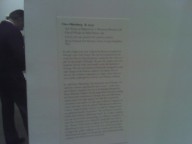It goes without saying that I can't go anywhere without seeing copyright issues lurking in the background. The last room of the Whitney's "Picasso and American Art," however, forced them to the foreground.
Throughout the exhibit, which showed Picasso artworks alongside American artworks they had inspired, were wonderful examples of transformative use -- artists from Max Weber to Jasper Johns taking elements from Picasso's work to create new art. Derivative works they might have been, but no one sued and the world is richer for them.
 In the final room, though, there appeared a litigation exhibit: Claes Oldenburg's "Soft Version of Maquette for a Monument Donated to Chicago by Pablo Picasso, 1968" was apparently created to help a declaratory judgment plaintiff defeat the City of Chicago's claim to copyright in the Picasso sculpture, which Picasso had dedicated to the Chicago public. I hope I can find so eminent an exhibit-creator if ever I need one.
In the final room, though, there appeared a litigation exhibit: Claes Oldenburg's "Soft Version of Maquette for a Monument Donated to Chicago by Pablo Picasso, 1968" was apparently created to help a declaratory judgment plaintiff defeat the City of Chicago's claim to copyright in the Picasso sculpture, which Picasso had dedicated to the Chicago public. I hope I can find so eminent an exhibit-creator if ever I need one.
 A storekeeper wanted to use a photograph of the Picasso to help customers find his store, and a publisher wanted to market copies of the sculptre. The Public Building Commission of Chicago objected. The court found no permission was needed because the work was in the public domain. Under the 1909 Copyright Act, the City's publication without proper notice of copyright divested it of any claim to copyright (if even Picasso's dedication could have been read to give it to the Commission in the first place). Unfortunately for future Oldenburgs and publics, revisions to the Copyright Act have done away with the requirement of formal notice of copyright, cutting off that avenue for works to enter the public domain.
A storekeeper wanted to use a photograph of the Picasso to help customers find his store, and a publisher wanted to market copies of the sculptre. The Public Building Commission of Chicago objected. The court found no permission was needed because the work was in the public domain. Under the 1909 Copyright Act, the City's publication without proper notice of copyright divested it of any claim to copyright (if even Picasso's dedication could have been read to give it to the Commission in the first place). Unfortunately for future Oldenburgs and publics, revisions to the Copyright Act have done away with the requirement of formal notice of copyright, cutting off that avenue for works to enter the public domain.
 Of course there's a coda to this story: As I was reading the museum label's account of this story, I thought I'd snap a Treo picture of the label as aide memoire -- only to hear a museum guard say, without irony, "no photography." Hence the blurriness of this image.
Of course there's a coda to this story: As I was reading the museum label's account of this story, I thought I'd snap a Treo picture of the label as aide memoire -- only to hear a museum guard say, without irony, "no photography." Hence the blurriness of this image.
Prohibitions against photography in museums have more to do with the deleterious effects of the flashes on cameras than copy restriction. Not that guards or lower level employees usually know that. (Non-flash photography usually requires tripods - which are also usually forbidden for the purely practical reason that people trip over them.)
Posted by: naranj on February 20, 2007 09:56 AM*sigh*
That doesn't read the way I intended.
Flashes have a deleterious effect on _artwork_.